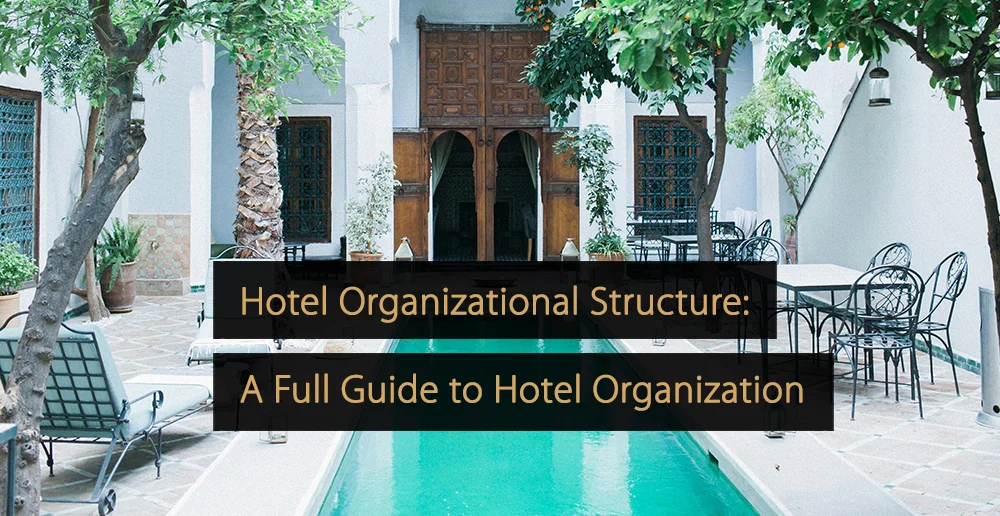Hotel organizational structure is the hierarchy through which decisions and actions are made within hotels. It can be thought of as a continual flow of communication within a strict hierarchal system that ensures message coherency. Hotel organization is an important element of the hospitality system in large part due to the industry’s complexity. A hotel needs to accommodate the needs of many fast-paced interactions within a constantly changing customer base. In this article, you’ll learn how to analyze a hotel’s organizational structure, interpret organizational charts, understand various roles, and more.
Table of Contents:
- What Is the Hotel Industry?
- What Is Hotel Management?
- What Is a Hotel Organizational Chart?
- Why Is a Hotel Organizational Chart Important?
- Hotel Organizational Chart – Hotel Management Functions
- Types of Hotel Organizational Charts
- 5 Steps to Make a Hotel Organizational Chart
- Hotel Organizational Structure Is Built on Individual Departments
- Hotel Organizational Structure and the Hiring Process
What Is the Hotel Industry?
The hotel industry is itself a vital part of the larger hotel organizational structure. The term essentially deals with a specific element of the hospitality industry – services that relate to overnight stays and related elements. This might seem like a narrow focus at first. However, a hotel, motel, bed and breakfast, luxury spas, or even lodgings on boats would fall under the banner of the industry.
It also has a global reach, with many brands extending all over the world. The industry isn’t just popular either; it’s one of the leading job providers. For more information about the hotel industry, read “Hotel Industry: Everything You Need to Know About Hotels!”
What Is Hotel Management?
Hotel management is the primary organizational element in charge of the larger-scale operation of a hotel. It’s essentially the top of the hotel organizational structure and is the person who sets the direction for it. However, the term is more specifically used for the hotel’s general manager. This position doesn’t just direct staff, it also involves processing feedback from department heads managing their own duties.
The level of delegation is often dependent on the size of a particular hotel. A large franchise might require a larger chain of communication between the manager, department heads, and employees. For more information about hotel management, read “Hotel Management: Everything You Need to Know About Managing a Hotel.”
What Is a Hotel Organizational Chart?
A hotel organizational chart can be thought of as a map of the hotel departments and their components. Each element is shown in relation to the others and indicates how they can all work together. Some of the elements found on these charts include leadership of departments, roles, jobs assigned on a day-to-day basis, and responsibilities for projects both large and small. While the charts are always visually oriented, the exact methodology can differ on a case-by-case basis. Tree charts are the most common format. However, any system that can designate hierarchies can be used.
Why Is a Hotel Organizational Chart Important?
The importance of a hotel organizational chart stems from the complexity of a hotel organizational structure. It’s often quite difficult to plan, discuss, and implement strategies within complex systems without a visual representation of everything. Hotel operations are normally difficult to describe in detail due to the lines of authority, hierarchies, changing roles, and overall structure. An organizational chart can make many of these normally difficult-to-understand elements clear at a single glance. These detailed charts provide clarity on operations and the role of individuals within the hotel’s structure. This allows for improved planning.
Video: Hotel Operation Structure
Hotel Organizational Chart – Hotel Management Functions
You’ll often find that there’s a greater hotel meaning to phrases used within the industry. And the following terms have special importance within the context of managerial functions.
Owner & General Manager
The general manager and owner are at the top of the hotel’s chain of command. These two roles are only occasionally filled by a single individual. These are two of the most important positions as the overall policy and business strategy come down from them—likewise, the plans for any implementation. The hotel owner usually creates the initial policy, goal, and standards for the business. The general manager will then handle the day-to-day work required to turn those ideas into reality. Note that smaller hotels usually have only one person filling both roles.
Department Managers
Department managers are the people who manage the day-to-day operations of specific departments, such as housekeeping or human resources. They leverage expertise within their given niche. Department managers are an important part of the hotel business since they know one area in precise detail. Likewise, department managers provide larger-scale departmental accountability. The success or failure of a specific department rests on the shoulders of its manager. However, delegation is also an important part of the managerial role. Not just delegating tasks and responsibilities downward but also bringing important matters to the attention of assistant managers.
Operational Employees
Operational employees are the people working directly with tasks, like bellboys or front desk staff. They’re the people typically working to turn strategy into reality. They’re responsible for making the accommodation feel like home for guests. Likewise, they’re an important source of information about the overall opinions of the guests. While lower down in the hotel organizational structure, they’re a vital piece of the puzzle. Operational employees often think of simple ways to dramatically increase guest satisfaction. When guests think about the hotel they often recall the operational employees who offered help.
Types of Hotel Organizational Charts
- Hierarchical Hotel Organisational Chart: Departments like sales or logistics are categorized, with senior leadership at the top. It’s among the more traditional structures.
- Functional Hotel Organisational Chart: Positions are laid out through functions and requirements. However, it carries a risk of disrupting communication between departments.
- Matrix Hotel Organisational Chart: Avoids possible confusion seen in hierarchical charts and allows for structures to emphasize cross-departmental functionality.
- Flat Hotel Organisational Chart: Minimizes representation of management levels from executive to employee. It promotes self-management and is thus favored by start-ups.
5 Steps to Make a Hotel Organizational Chart
The hotel organizational structure is typically quite complex. However, the following five steps provide an easy way of breaking it down into manageable pieces.
Define the Hotel’s Structure and Objectives
Defining the hotel organizational structure is the foundation of your chart. This is a general description of the chart type and your intent for it. Definitions ensure that you understand hotel budget allocation, importance, and intent. It’s the key that tells all staff exactly what the chart is used for. You’ll need to investigate all positions within the hotel, the departments, and how communication functions between them. Additionally, it’s vitally important that you define your objectives so that you can develop an accurate analysis of whether you’re meeting them. This also aids the employee’s implementation.
Outline Key Roles and Departments Within the Hotel
Outlining the key roles and departments involved will provide information about what each department can provide. The positions for senior management should also be apparent. This element’s importance stems from the fact that it lists the dynamic elements of your hotel organizational structure. They’re the fundamental components of the chart. The major points to consider in this step are communication and reporting relationships. Show the function of each element along with the hierarchy and how it relates to everything. Some examples of the listed elements might be housekeeping or the front office.
Design the Organizational Chart
Designing the chart of your hotel organizational structure is typically done with computerized hotel technology. It should produce a clean and easily understood visual representation. This step is vitally important as it’s where the visual element is solidified. This is the point where you enhance how the information is communicated. You should begin at the top with senior management and then move down to department heads. Next, list each department’s individual roles. Likewise, illustrate cross-departmental teams and other unique elements. It’s important to stress lines of communication and reporting relationships. Aim for a self-explanatory visual design.
Review and Validate Your Work
When you review and validate your work, you’re not simply correcting minor errors. Rather, this step also gives you the chance to adapt to feedback. It’s an important stage for verifying your concept’s overall implementation. Leverage staff reviews and tweak data and presentation alike to create an optimized organizational chart. You should also make a point of spending extra time going over everything with senior management and the department heads. You’re aiming to leverage feedback from the people represented within the chart as well as those responsible for delegating tasks to achieve the hotel’s goals.
Distribute and Update the Chart
Distribute and update your work when it’s finished through whatever methods will best ensure full availability. Ensure people also understand that it’ll be continually updated. Distributing isn’t a one-time event but rather something that will happen whenever the hotel organizational structure changes. Likewise, when new plans are put into motion, elements might change at any time, for example, during hotel maintenance. Continually updating the chart and ensuring people know how to access those updates is a vital part of creating an organizational chart. The chart should always stay dynamic and highlight the hotel’s own growth.
Hotel Organizational Structure Is Built on Individual Departments
The hotel organizational structure is made up of individuals, positions, and departments. Proper organization and documentation of your hotel means fully understanding all of them. However, departments deserve special attention as they often act as hubs for particular duties and guest impressions. You should take time to learn how departments like the front desk or housekeeping operate. Likewise, track hotel trends and how they can improve departments. You can find out more about the divisions of a hotel in the article “Hotel Departments: Learn About All the Sections of a Hotel.”
Example: Hotel Organizational Chart for F&B Department
Hotel Organizational Structure and the Hiring Process
Hotel staffing has some obvious ties to elements like hotel financing. However, you should also consider how the hiring process influences your overall hotel organizational structure. One benefit of organizational charts is that you can easily see the areas where you could use more people. It’s a solid foundation on which to proceed with job interviews. You’ll know why and where you need people and can discuss it with applicants. You’ll discover how the hiring process works in the hospitality industry in the article “Hospitality Staffing: How to Hire the Best Hospitality Employees!”
Hotel organizational structure is complex, but it’s manageable complexity. If you use the information you’ve found here, then you can create a chart, plan, and goal. Then, follow up on the most interesting organizational points.
Did You Like This Article About Hotel Organizational Structure?
You might also be interested in the following articles:
- Hotel Budget Plan: Practical Budgeting Tips for Hoteliers
- Revenue Management Strategies to Grow Your Hotel Business
- The Latest Business Travel Trends Business Travellers Desire
- Hotel Investors: Advantages and Disadvantages of Investing in Hotels
- Hotel PMS: Customization and Automation
More Tips to Grow Your Business
Revfine.com is the leading knowledge platform for the hospitality and travel industry. Professionals use our insights, strategies, and actionable tips to get inspired, optimize revenue, innovate processes, and improve customer experience.Explore expert advice on management, marketing, revenue management, operations, software, and technology in our dedicated Hotel, Hospitality, and Travel & Tourism categories.
This article is written by:
Hi, I am Martijn Barten, founder of Revfine.com. With 20 years of experience in the hospitality industry, I specialize in optimizing revenue by combining revenue management with marketing strategies. I have successfully developed, implemented, and managed revenue management and marketing strategies for individual properties and multi-property portfolios.











Leave A Comment